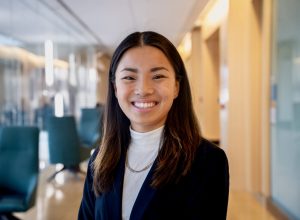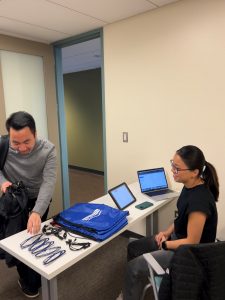My name is Isabel LoDuca, and I am a student at the University of Michigan studying business. This semester, I worked as a college and university partnerships intern focusing on conducting research, synthesizing findings, and developing recommendations on how AmFam could authentically show up in the college and university space, including by developing diverse talent pipelines and addressing student basic needs.
 Prior to my current internship at American Family Insurance, I worked as an intern as part of the Youth Climate Collaborative team.
Prior to my current internship at American Family Insurance, I worked as an intern as part of the Youth Climate Collaborative team.
As a final part of this semester’s work, I took a trip to the University of Washington to visit one of AmFam’s partners, the Brotherhood Initiative (BI), to learn about their Positive Social Change Challenge (PSCC), and better understand student innovation and civic engagement. The BI is a program designed to provide opportunities for academic and professional growth and support underrepresented men of color. The PSCC is a course required as part of the BI program that empowers students to create transformational change in their communities through action-based learning.
This trip came after I conducted landscape research on this topic more broadly. What type of partnerships for students to learn about social impact exist? How do these partnerships impact communities? As a college student myself, would I find these partnerships meaningful?
I posed similar questions to BI students in a focus group I led at UW about their student innovation experience. Combining research, their thoughts, and mine, here’s what I learned:
Finding #1: Many schools have social innovation, civic engagement and change making programs, but few allow students to use their lived experiences to shape their program experience.
The most impactful student innovation and civic engagement partnerships are focused on uplifting student voices and empowering them to understand their capacity as change makers in their own communities. At their best, these programs are not restricted to one specific impact area or restricted to MBA students. Instead, they allow students to take their lived experiences, interests, and dreams and develop an actionable deliverable. After deep diving into 5 universities across the Midwest and East Coast, I discovered that many programs fail to create space for personalized and start– to– finish collaboration on social innovation learning endeavors. They often consist of one-off events and/or structured coursework with limited flexibility on topic exploration. 
In my experience, I had limited opportunities to take courses or participate in programs that utilized my own lived experiences and resulted in real-life applications in my coursework. I personally turned to internships like my two with AmFam to fill this gap. For example, I began a nonprofit in high school that was focused on the intersection of climate and business. To take my interest in climate advocacy further, I utilized my own experiences as a GenZ student and learned expertise to help influence the creation of AmFam’s YCC. By supporting existing programs and the creation of new programs that center around individuals’ own life experiences, students can reach their fullest potential as changemakers in areas of impact they care about the most.
Finding #2: Academic spaces made by and for students empower students. Physical space matters.
During the focus group, I asked the student participants if programs that dedicate academic space with students in mind impact their ability to be changemakers in their communities. The response was an astounding yes, with students explaining that spaces like these allow them to feel a sense of belonging in an academic setting that was not originally built for them. When we visited wǝɫǝbʔaltxʷ, the Intellectual House at UW, a learning and gathering space for American Indian and Alaska Native students, staff, faculty, and community members, the importance of physical space was also echoed. When students of different identities have places to feel safe, celebrate their culture, and meet students with similar lived experiences, students thrive. Spaces like these are especially impactful for students who are under-represented in their campuses, like the men and women of color in the BI and SI are at the University of Washington.
Finding #3: Success of social impact education is not always tangible and cannot always be quantitatively measured.
Oftentimes KPIs or business case justifications for community investment require tangible measurements of success. However, the intangibles – , such as self-confidence and a newfound sense of psychological safety, belonging, or purpose – create long-lasting impacts on students. These outcomes were clear in our focus group conversation, where each of the students we talked to who participated in the PSCC spoke about how their lessons on social impact in the classroom deeply instilled in them a sense of purpose and a desire to make an impact for their communities and those who will come after them.
The Brotherhood Initiative is also seeing incredible tangible outcomes. The collective impact of their work – including the PSCC, academic mentorship, experiential learning opportunities, and holistic, whole–person support – are driving success in college graduation rates. When student innovation and civic engagement partnerships are deemed a success – impact should be measured both through tangible and intangible measures, and business partners should make the time to understand both.
Finding #4: Authenticity is key to corporate partnerships with colleges and universities.
From my own experience and that of focus group participants, I see it is paramount for companies to engage with young people in an authentic manner. Student participants explained that at the end of the day, they don’t need unauthentic efforts on the part of companies to drive change. They are and will continue to do it themselves. At the end of the day, we Gen Z, can see through much of corporate America’s meager attempts to partner with students for transactional outcomes – whether that be to lure diverse talent, get their logo on a website, or write a one-off paragraph in a CSR report. Authentic partnerships can only be created by showing up consistently, going beyond the check, and creating long lasting personal relationships.

